Palatine Hill Guide: 10 Monuments to See
The Palatine Hill is one of the most famous ruins in Rome, and where the city’s story begins, I mean, literally.
As the legend goes, this is where Romulus founded the city in 753 BC after a dramatic showdown with his twin brother, Remus.
Located between the Roman Forum and the Circus Maximus, this ancient hill is full of ruins of palaces, temples, and gardens that tell the tale of Rome’s evolution from a cluster of huts to a city of emperors.
In this Palatine Hill guide, you will learn what monuments to see in the Palatine Hill in Rome.
So make sure to stop by and visit it, and just let your imagination roam free, trying to picture what life was like when emperors ruled this city.
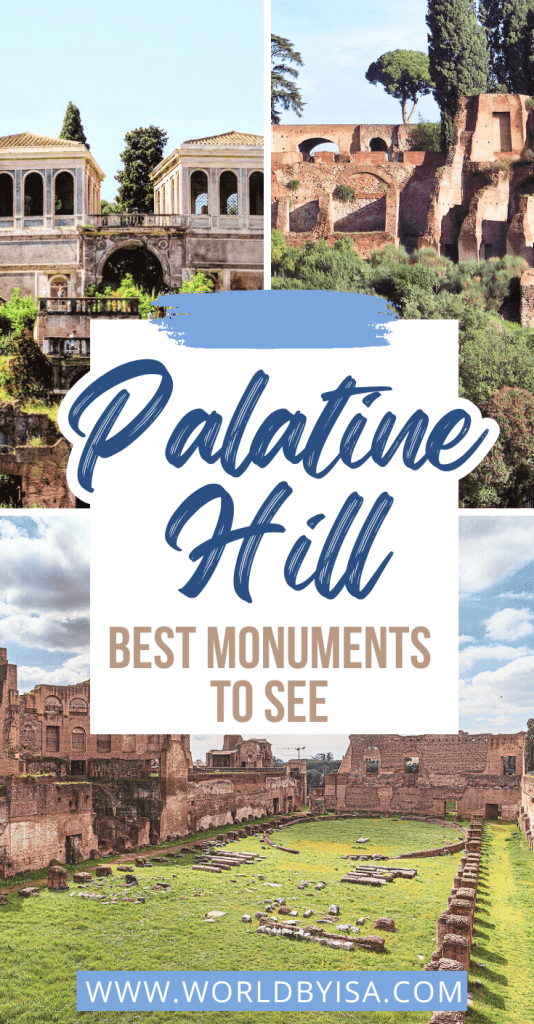
Disclosure: This post does contain affiliate links that I earn a small commission for at no extra cost to you. Any purchases you make through my links help keep the site running. Thanks in advance for your support!
Palatine Hill and the Funding Myth
Romulus and Remus
The history of Palatine Hill begins in the 10th century BC when the region received the first settlements.
The myth of the founding of Rome centers around the legendary twins, Romulus and Remus, whose fate would lead to the birth of one of the most powerful cities in history.
The story begins with Romulus and Remus, twin brothers born from the god Mars, and Rhea Silvia (sister of Numitor, the rightful king of Alba Longa) being abandoned.

The infants were placed in a basket and set adrift on the Tiber River, which eventually carried them to the shores of Palatine Hill.
According to the myth, there was a cave on Palatine Hill, where the she-wolf (lupa) lived, she discovered the crying twins and took them under her care.
With this, the image of the she-wolf suckling Romulus and Remus became a symbol of the city.
Fast forward some years, Romulus and Remus decided to fund the city of Rome, but couldn’t agree on where exactly to build their city.
Romulus preferred the Palatine Hill, while Remus favored the Aventine Hill.
They agreed to settle the dispute through augury, seeking the will of the gods by observing the flight of birds.
According to the legend, Remus saw six vultures, but Romulus claimed to have seen twelve, interpreting this as a sign of his favor.
Arguments escalated, and in the heat of their rivalry, Romulus killed Remus.
Romulus then became the sole founder of the new city, Rome, which he named after himself.

Palatine Hill during the Roman Empire
Because of its deep historical roots, Palatine Hill has always been a valuable area for the Romans.
During the republican period, between 509 and 27 B.C., emperors and aristocrats made this hill the place for their luxurious villages.
The first Emperor of Rome, Augustus, was the first to build his palace here, known today as the House of Augustus.
Attached to the House of Augustus, is the house of his wife, known as the House of Lívia.
After him, other emperors took up residence in the neighborhood.
The practice of building palaces on Palatine Hill has become so common, that the word palace itself derives from the Italian word Palatino.
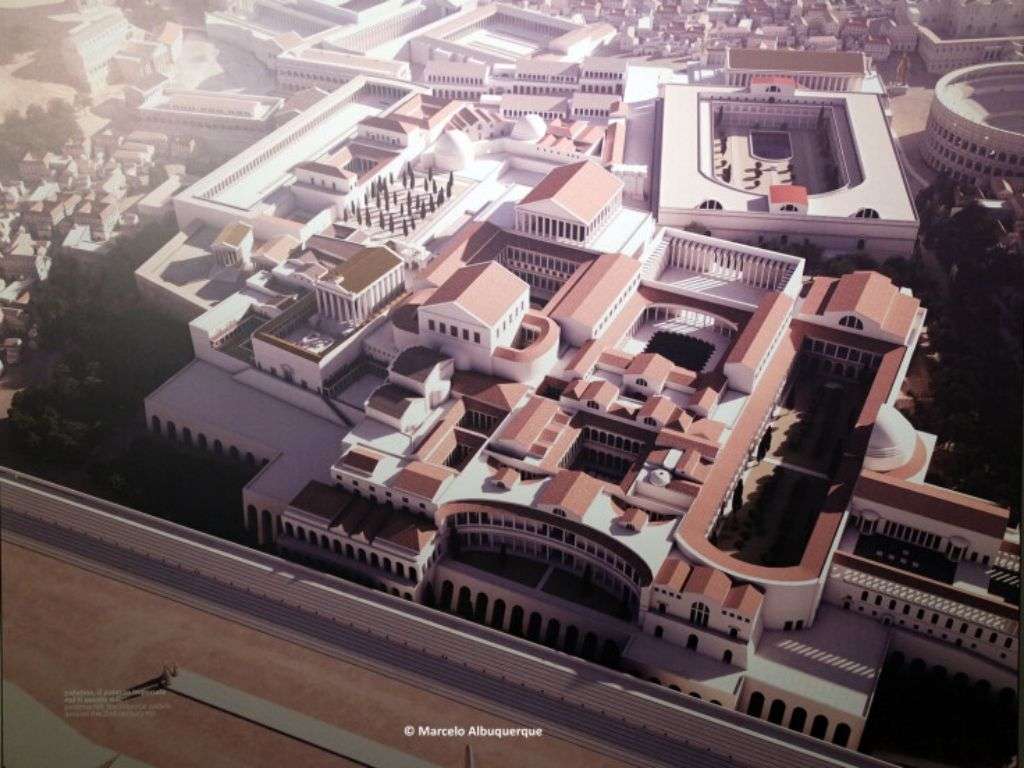
What to see in the Palatine Hill
Both Palatine Hill and the Roman Forum are famous for the number of ruins in these two sites.
However, while the Roman Forum has many ruins from temples to political buildings and markets, Palatine Hill, on the other hand, counts fewer ruins, as it was a more residential area rather than serving many purposes like the Roman Forum.
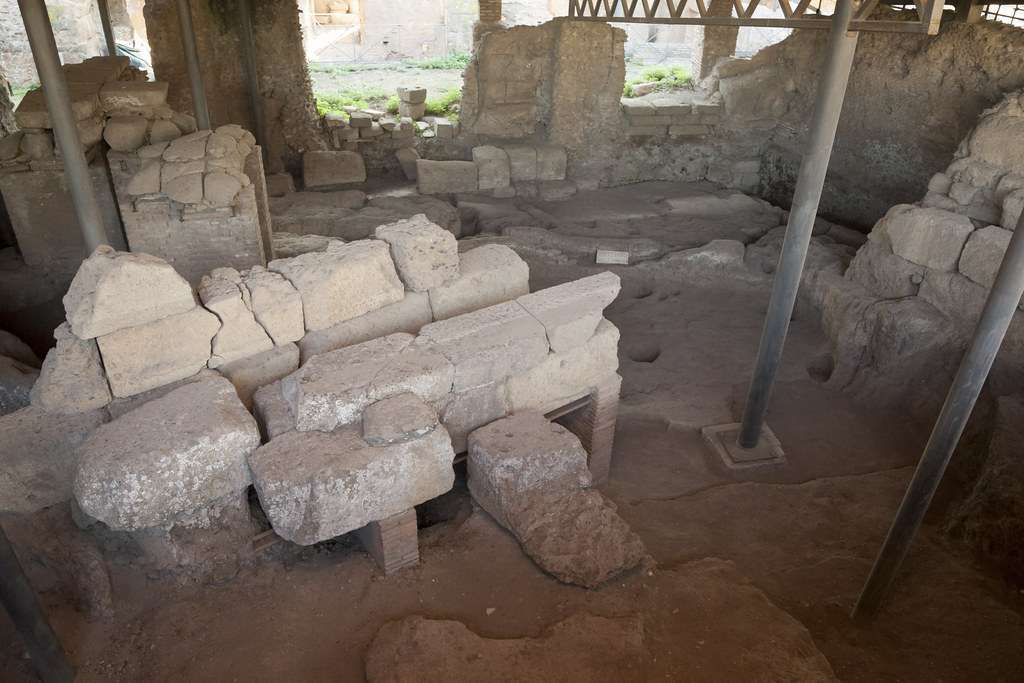
1. Hut of Romulus
Although Romulus is considered a mythological figure, as we still don’t have strong evidence of his actual existence, archaeological excavations started by the emperor Augustus himself found artifacts from the Iron Age and ancestral huts in the area.
The huts are located on the southwestern corner of the Palatine hill, on the slope facing the Circus Maximus. Archeologists believe one of these huts could have been of Romulus, receiving the name Casa Romuli or Hut of Romulus.
It was a traditional single-roomed hut, with a straw roof and wattle and daub walls.
Unfortunately, the Casa Romuli has been heavily damaged throughout the centuries.
Records show that ceremonies were held in the hut, probably in honor of Romulus.
In one of these ceremonies, the hut ended up being burnt during a sacrifice, probably due to the altar fire running out of control.
Also Read: 20 Must-Visit Ancient Roman Ruins in Rome
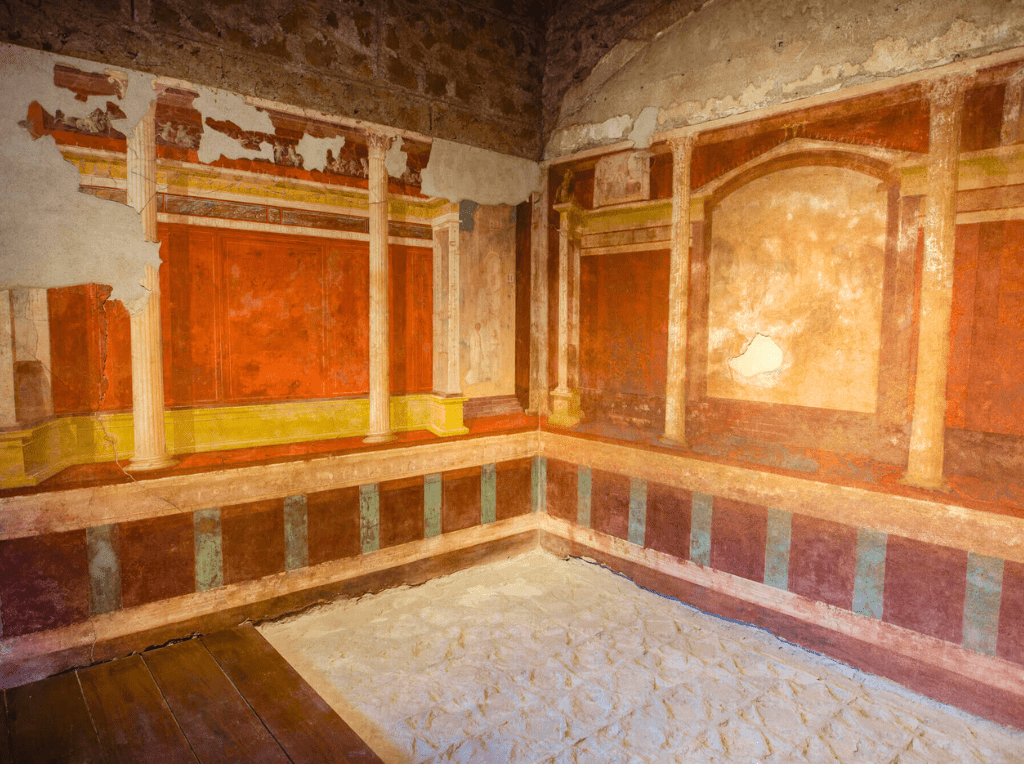
2. House of Augustus
This was the private residence of Augustus, the man who transitioned Rome from a republic to an empire.
Unlike what you’d expect from the ruler of such a vast empire, Augustus’s house wasn’t an overly showy palace.
Instead, it was relatively modest in size and design, reflecting the image he wanted to project as a leader who valued tradition and humility.
But don’t be fooled, it was still packed with enough elegance to remind visitors who lived there.
What really stands out about the House of Augustus are the stunning frescoes that have survived through the centuries.
The vibrant, detailed wall paintings show scenes of mythology, nature, and intricate patterns, showcasing the artistry and taste of the time.
Rooms like the Room of the Masks and the Room of the Pine Festoon are famous for their theatrical and lively imagery, giving us a glimpse into the aesthetic preferences of Rome’s elite.
Best Guided Tours of the Palatine Hill
However, to visit the House of Augustus you will have to it is make an appointment at the entrance to the archaeological park of Palatine Hill. Otherwise, you can guarantee your visit by booking this special House of Augustus and House of Livia tour.
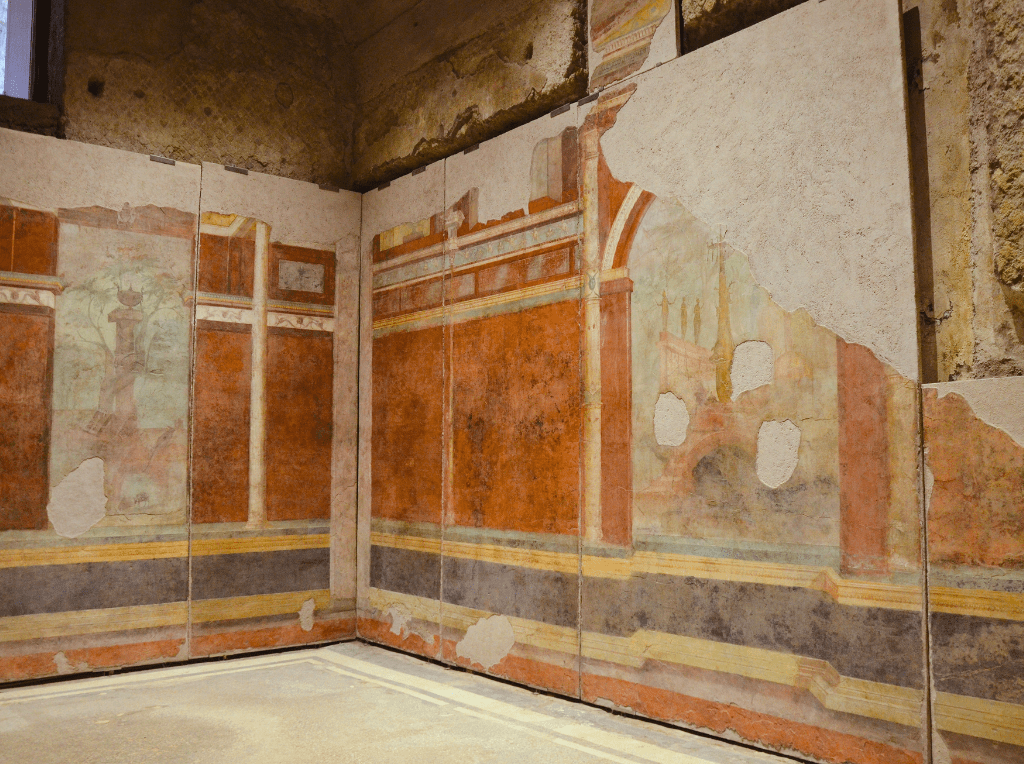
3. House of Livia, Palatine Hill
Livia Drusilla, the wife of Emperor Augustus and an influential figure in her own right, lived in this beautifully decorated residence.
Unlike grander palaces that came later, the House of Livia, like the House of Augustus, has an elegant simplicity that displays the refined tastes of Rome’s first imperial family.
The vibrant wall paintings feature detailed scenes of nature, gardens, and mythological themes, revealing how Romans brought a touch of the outdoors inside.
The Room of the Fruit Garden is one of the highlights, depictions of birds, plants, and fruits cover the walls.
Again, to visit the House of Livia you have to make an appointment first, or if you want to guarantee your visit, you can book the House of Augustus and House of Livia tour.
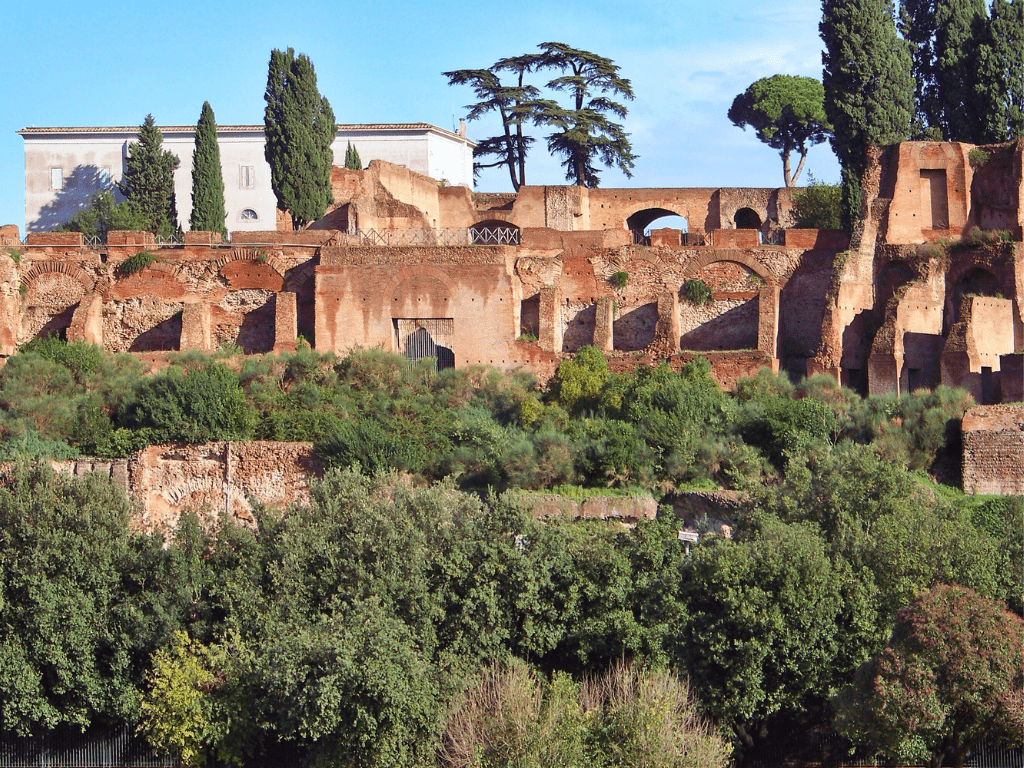
4. Temple of Apollo Palatinus
The Temple of Apollo Palatinus was one of ancient Rome’s most significant religious sites, built by Emperor Augustus himself.
Dedicated in 28 BCE, this temple symbolized not just devotion but a statement of Augustus’s divine connection and his role as Rome’s leader.
He credited Apollo with aiding him in his military victories, so it made perfect sense to construct a temple of grand proportions right next to his own residence.
The building itself was a stunner, adorned with marble and featuring a beautiful colonnade, showing off Augustus’s ambition to make Rome the pinnacle of cultural and spiritual excellence.
It was home to beautiful statues, including one of Apollo with a lyre, reinforcing the god’s association with music, prophecy, and the arts.
The temple also housed the Sibylline Books, ancient prophetic texts that were consulted during times of crisis, adding another layer of sacred importance.
Also Read: How Many Forums Did Rome Have?

5. Domus Tiberiana
The Domus Tiberiana is one of the lesser-known but still impressive palaces on the Palatine Hill, linked to Emperor Tiberius, who succeeded Augustus as Rome’s ruler.
Built in the early 1st century AD, this palace marked the first major expansion on the hill, signaling a shift from the simpler homes of earlier emperors to more extravagant residences.
While it started as Tiberius’s home, the Domus Tiberiana eventually became a key part of the sprawling imperial complex, housing several later emperors who added their own touches to it.
One of the interesting things about the Domus Tiberiana is its strategic location.
Perched on the northwest side of the Palatine Hill, it offered exclusive views over the Roman Forum, allowing emperors to keep an eye on the heart of their city.
The structure itself was massive, featuring large courtyards, grand halls, and elaborate living spaces, all designed to emphasize the power and prestige of the Roman emperor.
The palace was connected to the rest of the imperial complex, giving Tiberius and his successors plenty of room to conduct official business or retreat into private life, as he liked.
Best Guided Tours of the Domus Tiberiana
You can visit Domus Tiberiana on this guided tour, which also includes the Roman Forum and Palatine Hill.
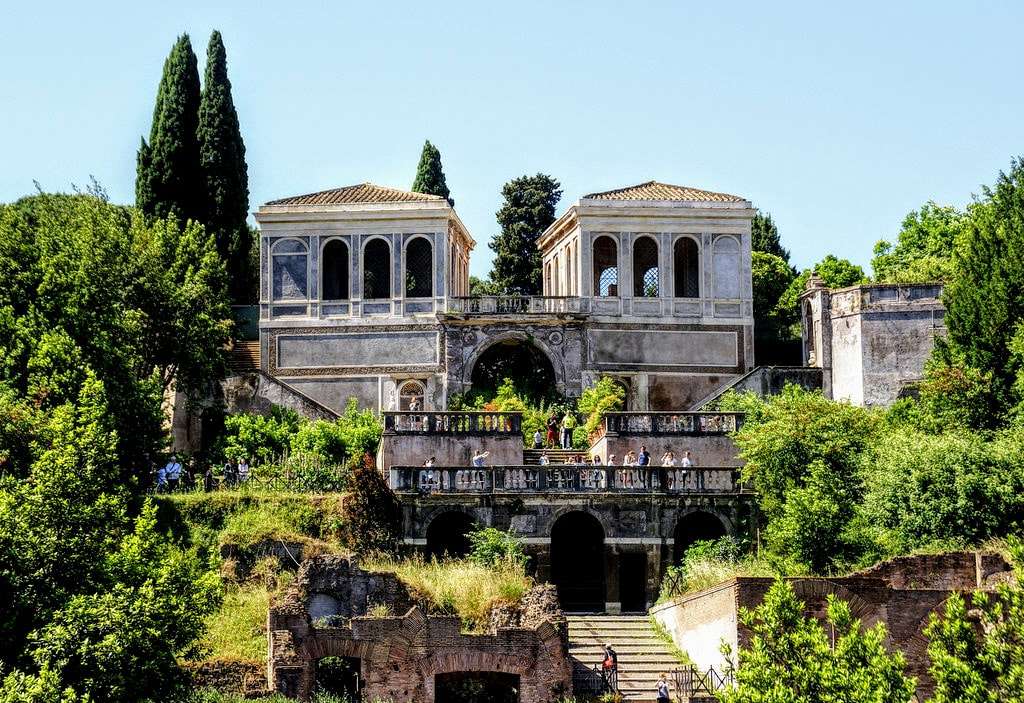
6. Farnese Garden
Considered one of the first botanical gardens in Europe, the Farnese Garden was built on the ruins of the Palace of Tiberius.
The garden was designed in the mid-16th century by Cardinal Alessandro Farnese, who acquired the ruins of the old Palace.
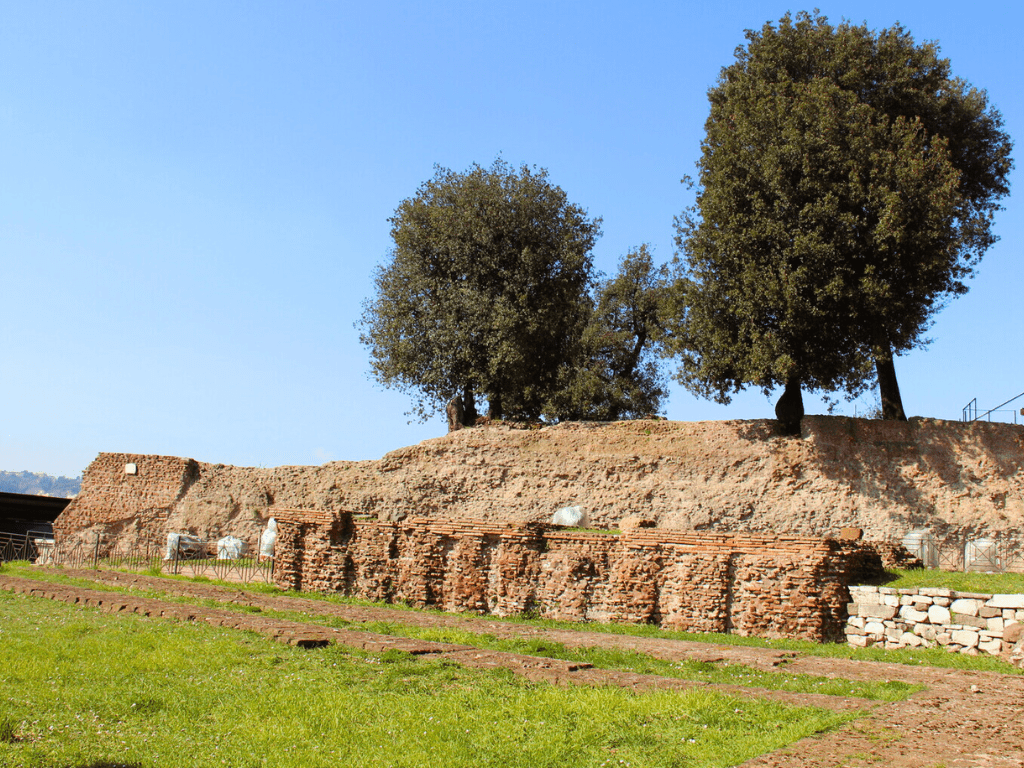
7. Cybele Temple
Better known among the Romans as the Temple of the Magna Mater (The Great Mother).
Dedicated to the Great Mother of the Gods, this temple was established in 191 BCE after the Romans brought her worship from Anatolia (modern-day Turkey) to help during the Second Punic War.
The Romans believed that Cybele’s powerful, wild energy would grant them victory, and she became one of their most revered goddesses.
The temple was built to house a black stone or meteorite believed to embody the goddess Cybele herself.
This sacred stone, known as the Magna Mater’s sacred stone or baetyl, was said to have originated from Phrygia (also in modern-day Turkey) and was brought to Rome in 204 BC as part of her cult’s establishment.
According to ancient sources, the arrival of this black stone in Rome was surrounded by fanfare and viewed as a divine sign.
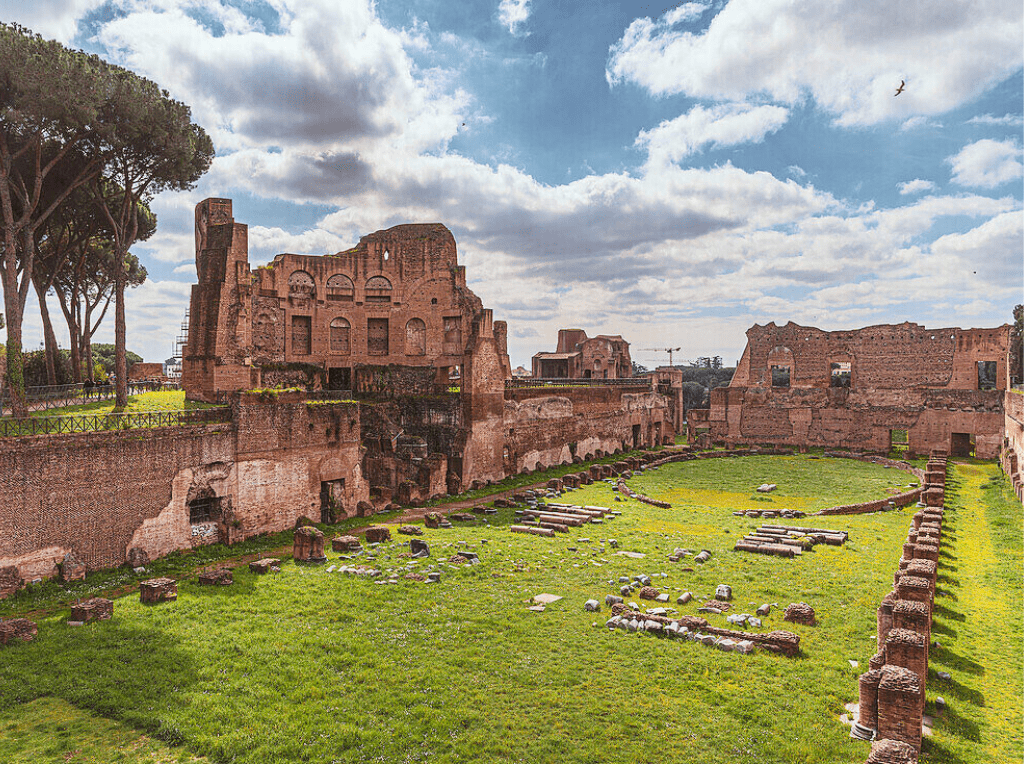
8. Domitian Palace, Palatine Hill
The Domitian Palace, also known as the Palace of Domitian or the Flavian Palace, is a monumental complex in Palatine Hill.
Built in the 1st century AD for Emperor Domitian, it was designed by the architect Rabirius and served as the main residence for Roman emperors for over 300 years.
Unlike the more understated homes of Augustus or Livia, Domitian’s Palace was all about showing off.
It was a space that shouted power and authority.
The palace itself was split into three main sections: the Domus Flavia (the public wing), the Domus Augustana (the private residence), and the Stadium of Domitian, which might have been used as a private garden or arena.
While the palace has crumbled over the centuries, you can walk through what’s left of the reception halls, peek into the private living quarters, and imagine the emperor walking across marble floors.
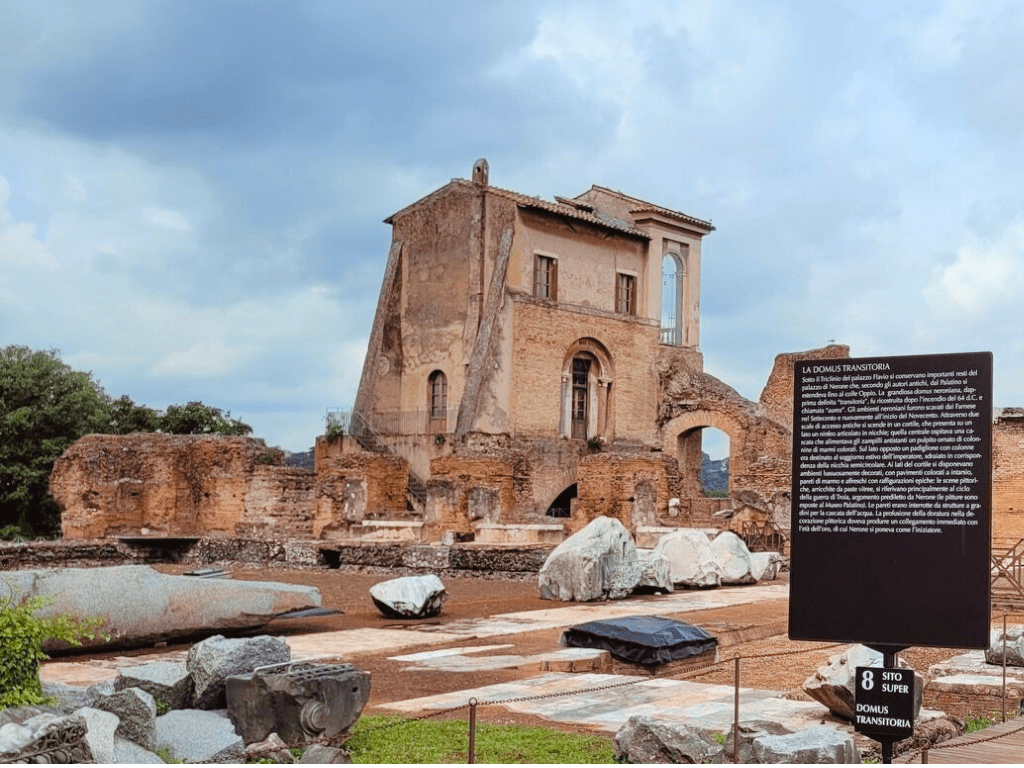
9. Domus Transitoria, Palatine Hill
The Domus Transitoria was Emperor Nero’s first palace.
Located on Palatine Hill, it connected various properties across the hill creating a seamless transition, hence the name Transitoria, meaning “passageway.”
Nero envisioned it as a space that would bridge the Palatine with other significant parts of Rome, giving him easy access to the city’s most important areas.
Though much of the Domus Transitoria was lost to history when the Great Fire of Rome in 64 AD swept through the city, what remains gives a good idea of its opulence.
Archaeological discoveries have revealed frescoes, marble floors, and rooms designed with an eye for drama and splendor.
The famous rotating dining room, rumored to have been part of this palace, shows Nero’s love for spectacle, it supposedly had a mechanism that mimicked the movement of the heavens, giving guests a truly unique experience during the dining.
This was Nero’s first major move in reshaping Rome to fit his grand vision.
After the fire, Nero replaced the Domus Transitoria with the even more lavish Domus Aurea (Golden House).
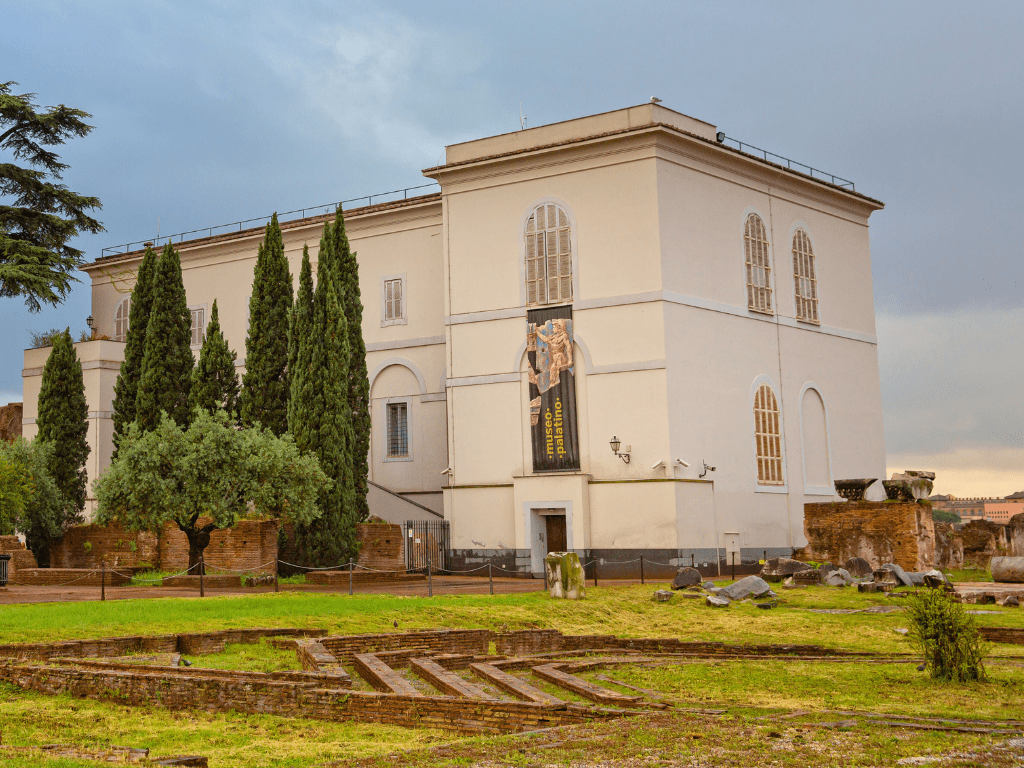
10. Palatine Museum
The small museum located on Palatine Hill displays archaeological finds discovered on the mount itself.
Among the artifacts are sculptures, mosaics, frescoes, and other objects from the glory days of Palatine Hill.
The museum covers the history of the place from its origins to the imperial period and helps to tell the history of the city of Rome.
How to Visit the Palatine Hill
Ticket
You can access Palatine Hill by buying the Colosseum, Roman Forum, and Palatine Hill priority ticket.
It is important to note though that some ruins, such as the House of Livia and House of Augustus demand an extra ticket and/or previous appointment.
The ruins that demand extra tickets or appointments are mentioned within the text, alongside suggestions of tours that include them.
Basic Information
Opening hours
Open every day from 8:30 am until one hour before sunset.
Remember that Palatine Hill is closed on January 1st and December 25th.
How to get there
In my opinion, the most practical option is to go by metro, via line B, and get off at Coliseum station, which is right in front of the Colosseum and next to Palatine Hill.
Another option is by bus, the lines that pass near Palatine Hill are 60, 75, 84, 85, 87, 117, 175, 186, 271, 571, 810, and 850.
This text was originally written and posted in April 2020 and updated in November 2024. New information has been added and links have been updated so that it could offer a better experience to the reader.
More About Italy
- 20 Must-Visit Ancient Roman Ruins in Rome
- How did The Roman Forum Look Like Before Excavations?
- How Many Forums Did Rome Have?
- Did Gladiators ever fight Lions?
- 3 Days in Rome Itinerary
- Christmas in Rome: Best Things to Do
- How to get to Rome Termini from Fiumicino Airport
Italy Travel Essentials
- FLIGHT TICKET: Get the best flight deal with Skyscanner.
- ACCOMMODATION: Find the perfect accommodation on Booking.
- VISA: Apply for a Visa on iVisa.
- eSIM: Stay connected throughout your trip with Airalo eSim. It offers packages from 7 to 30 days for accessible prices.
- PRIVATE TRANSFER: Book your private airport transfer.
- RENT A CAR: Find the best rates on DiscoverCars.
- GUIDED TOUR: Find the best tours in Italy on GetYourGuide
PIN IT!
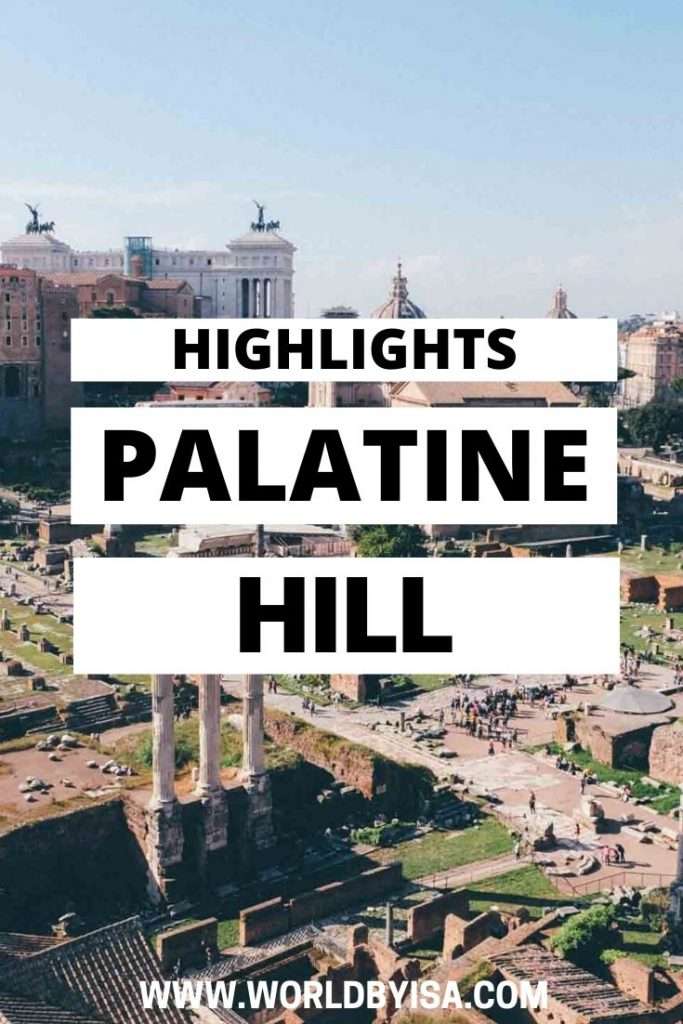





Hello! This is a trip that definitely impressed me! The ancient architecture is amazing! I want to be there!
Definitely, and it is so worth visiting! Visiting ruins is a truly unique experience, just to imagine everything that those ruins ‘have seen’ during the centuries, is mindblowing!